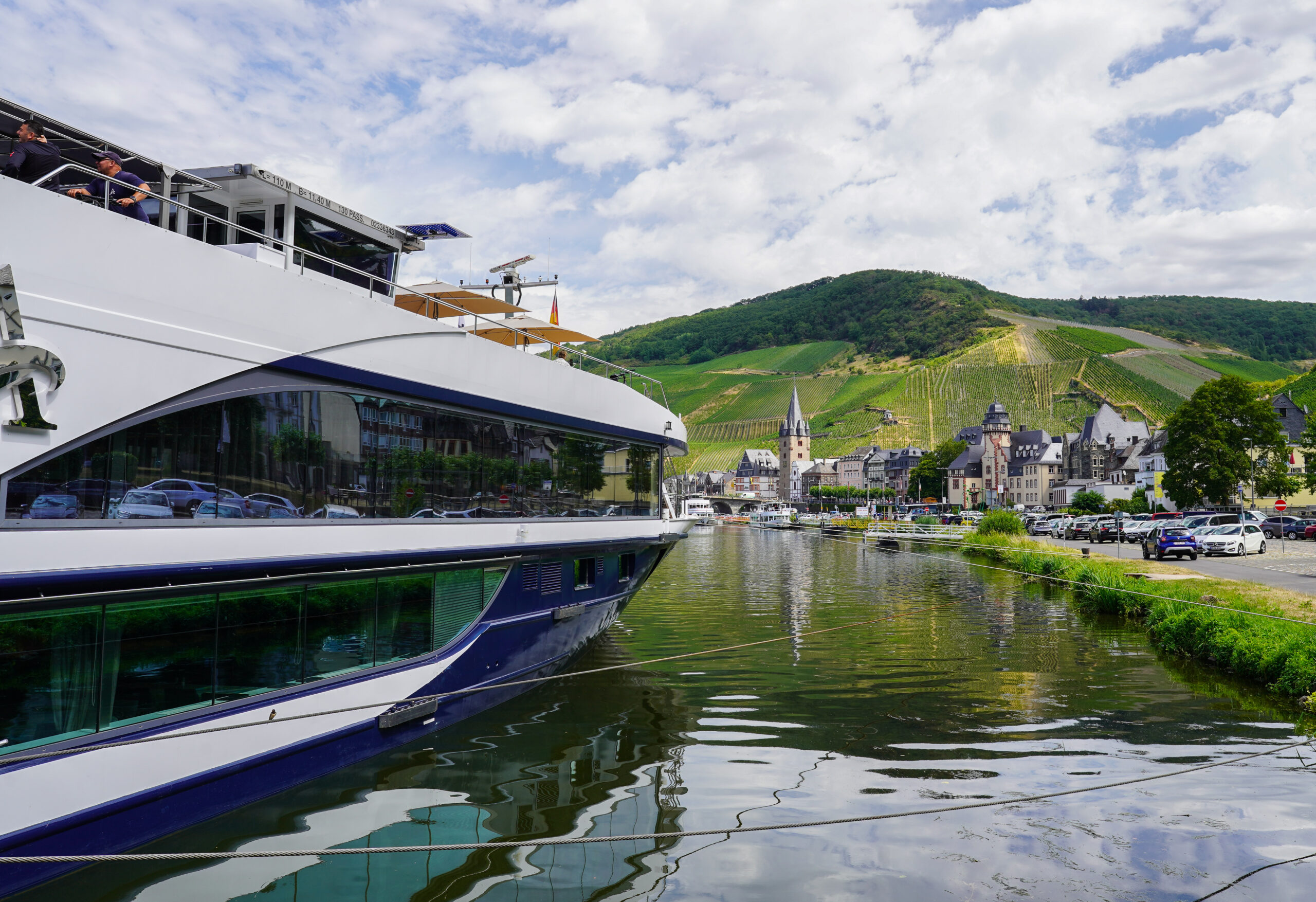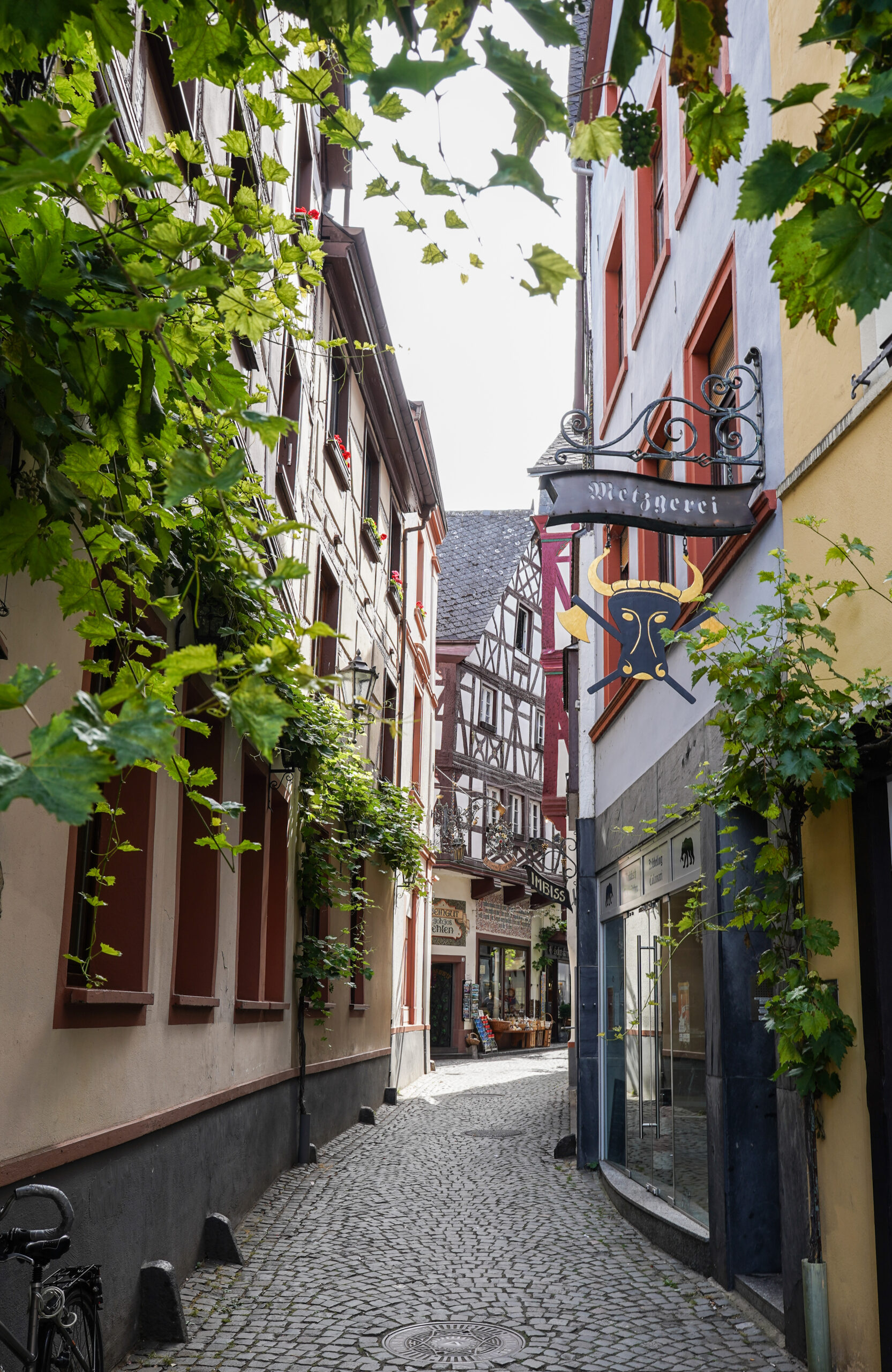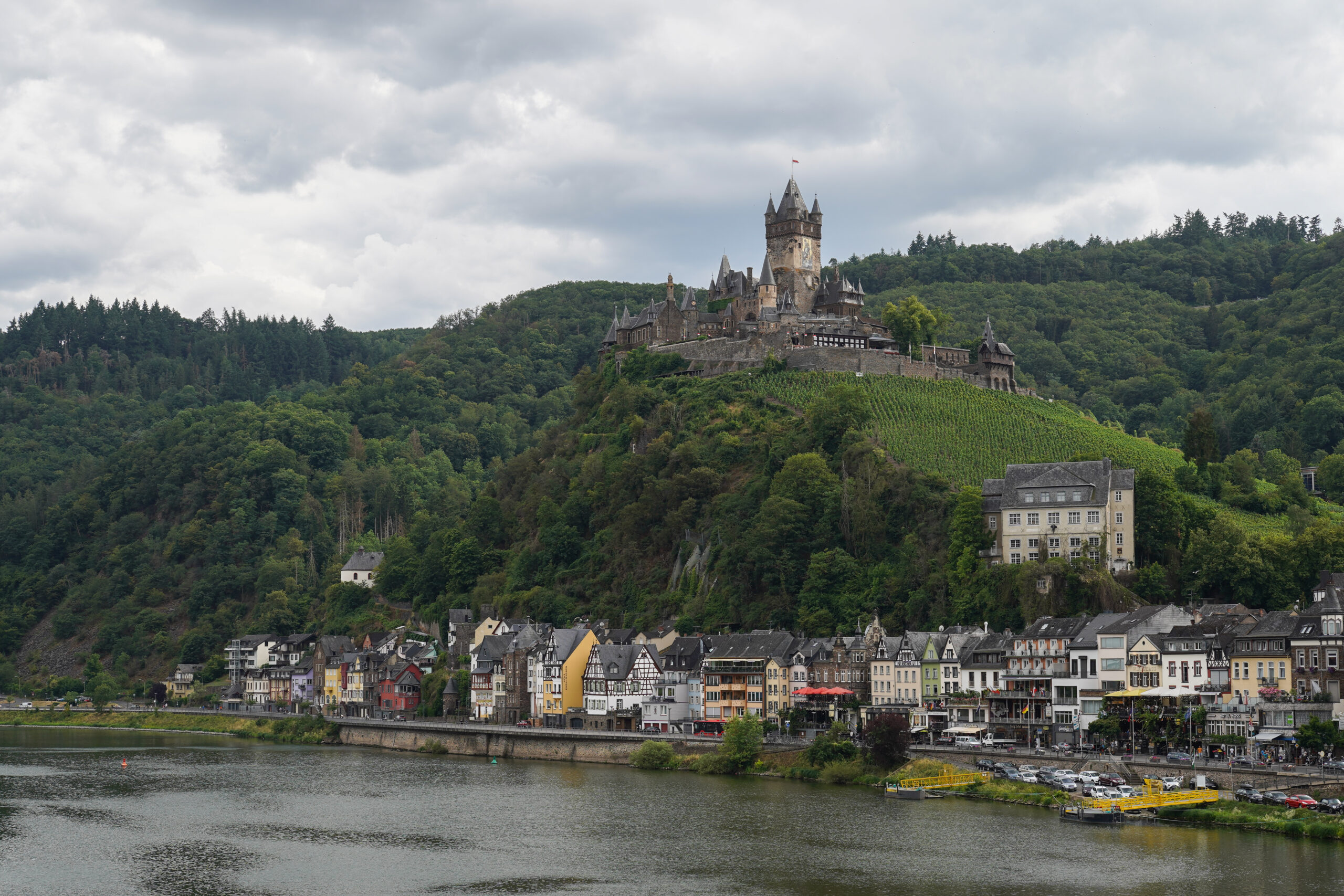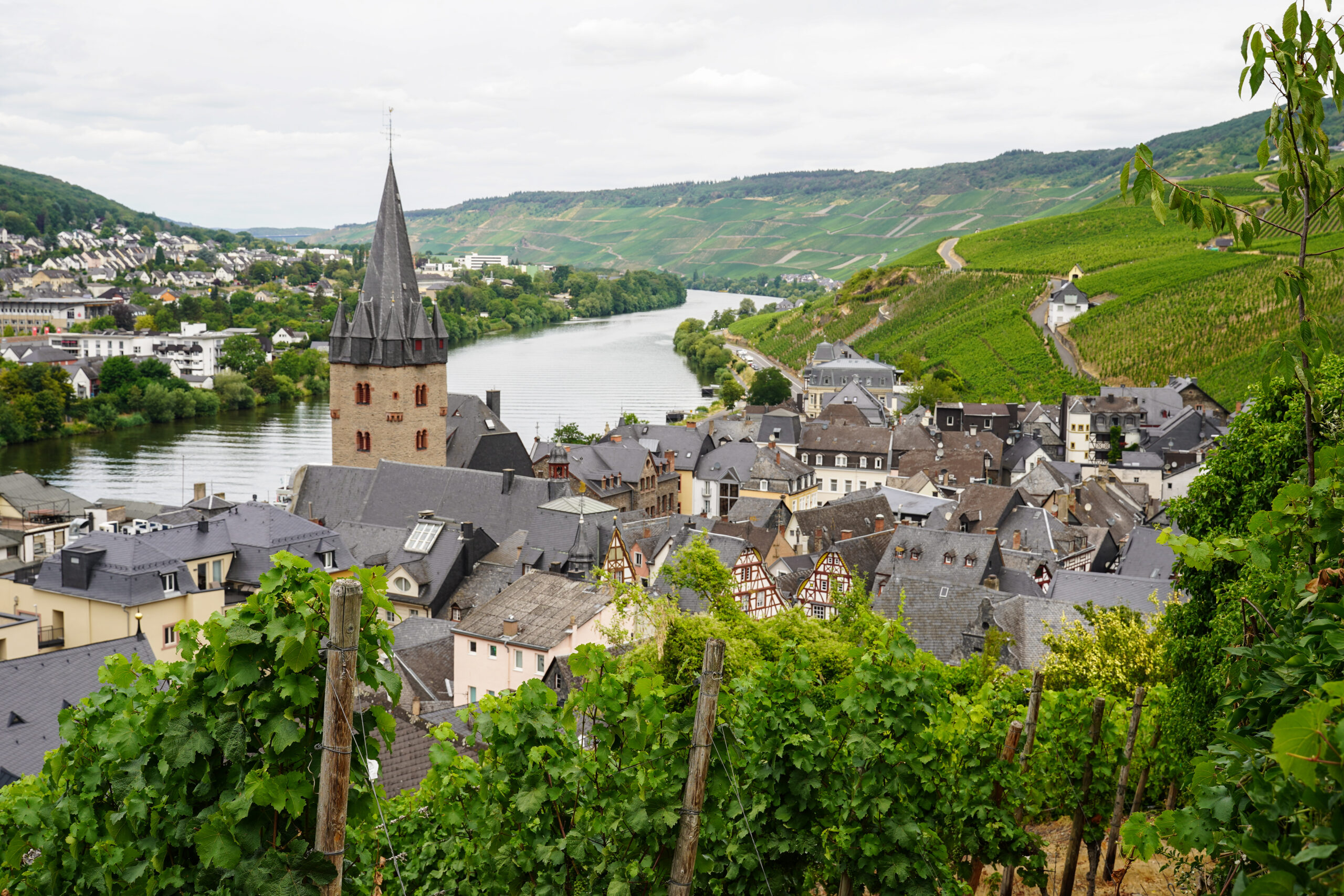Sunlight streamed through my window, waking me to a postcard-perfect view: gabled, timber-framed houses and terraced vineyards in Bernkastel-Kues, Germany. I’d overslept, so instead of lingering over a leisurely breakfast, I grabbed a quick coffee, laced up my hiking shoes, and snagged a couple of pastries to go. Minutes later, I joined a small tour group led by Karl, a local guide whose infectious love for his hometown was evident from the start.
Strolling through Bernkastel’s cobblestoned streets, we paused in the market square to admire the much-photographed Spitzhäuschen (“pointed house”), a delightfully off-kilter half-timbered building dating back to 1416. From there, we passed through Graacher Tor, a fortified town gate built around 1300. In a more mainstream European destination, these landmarks would have been swarming with tourists, cameras snapping away. But here, in this charming town of over 6,500 either side of the Moselle River, our little group had the historic streets practically to ourselves.
Before long, we left even the locals behind as Karl guided us along one of his favourite hikes: a shady, forested trail following the Tiefenbach Gorge, past an enchanting waterfall, and up to the 13th-century Landshut Castle. Perched high above Bernkastel, the stone ruins weren’t exactly fairy-tale material—especially compared to the architectural confections I’d see later—but the panoramic views of the Moselle River more than made up for their modesty.

From the castle, lush, vineyard-clad hillsides rolled down to the medieval town below, where our 128-passenger cruise ship, the Avalon Imagery II, floated serenely at the river’s edge. The scene was so captivating I couldn’t resist snapping a few photos. Moments later, I caught myself framing the ship through a castle window. It felt like a plot twist in my own travel narrative: me, taking scenic photos of a cruise ship?
Like many travellers, I’d always assumed cruises weren’t for me—dismissing them as overcrowded, environmentally unsustainable floating mega-resorts. Then my sister began raving about river cruises. I’d pictured these long, narrow boats as stuffy and dull, but she insisted I’d love their leisurely pace and the way they immerse you in the heart of a region. So when the opportunity to explore Germany’s Moselle River with Avalon Waterways came along, I decided to take the plunge. Armed with sturdy walking shoes and a bit of skepticism, I boarded the boat in Luxembourg, ready to see for myself.
The first surprise was the vessel’s intimacy. With just 52 suites and 12 staterooms, the 110-metre ship felt more like a boutique waterfront hotel than a traditional cruise ship. On my way to my cabin, I met the first of my fellow passengers: a friendly couple from Maryland, also first-time cruisers, and then a group of retired friends from England now on their seventh or eighth river voyage together. Once I settled into my cabin, the view from its floor-to-ceiling windows tempted me to linger—but curiosity won out, and I headed to the lounge for a welcome drink and a chance to meet the crew.
Taking a seat by the window, I watched as the room filled with a diverse group of guests—the second surprise. River cruises, I’d learned, have been shedding their sedate reputation. This ship offered something for everyone: active hikes and bike rides, hands-on classes, and curated walking tours alongside the more traditional bus excursions. By the end of the welcome orientation, I’d already connected with a lively mix of people, from solo adventurers to multigenerational families, all eager to explore together over the next eight days of our Active & Discovery cruise on the Moselle sailing from Remich, Luxembourg, to Frankfurt, Germany.
Stretching 546 kilometres from its source in the Vosges Mountains to its confluence with the Rhine at Koblenz, the Moselle River meanders through northeastern France, Luxembourg, and western Germany. As an often overlooked counterpart to the Rhine, Danube, or Seine, its understated charm is part of the appeal. For centuries, the Moselle’s banks have nurtured ancient towns and Germany’s earliest vineyards, all remnants of a time when rivers served as Europe’s essential highways.

Today, this rich history—and the Moselle’s relative obscurity—enhances its allure. It’s not overrun with tourists, a quality I’d begun to seek out as communities in more popular destinations continue to contend with the pressures of overtourism. This shift not only leads to warmer welcomes in places eager for visitors but also allows me to experience destinations that feel refreshingly unfamiliar—both to me and to my camera lens.
This sense of discovering somewhere new grew with every shore excursion. Hiking along the tranquil trails of Laacher See, I was struck by the lake’s deceptive calm. As our guide explained, its serene expanse lies within a volcanic caldera formed by a prehistoric eruption so powerful that its ash dammed the Rhine. Today, volcanic gas still bubbles to the surface, a subtle reminder of the forces beneath. Ducks paddled undisturbed as the guide shared tales of the eruption’s destructive magnitude—a vivid contrast to the peaceful scene before us.
Avalon’s focus on unique, local experiences was clear throughout the trip. “By working closely with the people in the places we dock, we can offer off-the-beaten-path alternatives,” says Pam Hoffee, president of Avalon Waterways. Whether it’s foodie walking tours, hands-on workshops like language or painting classes, or more active pursuits like hiking and biking, she says the goal is to offer activities that connect guests to the region in meaningful ways.
Sustainable tourism consultancy Sea Going Green highlights that employing local expert guides plays a vital role in supporting the cultural sustainability of port communities. Other effective measures include sourcing locally produced food and beverages, exploring lesser-known rivers, and extending the sailing season. On-board the Imagery II, Avalon demonstrated its commitment to sustainability through initiatives like eliminating single-use plastics, reducing paper consumption, and partnering with communities to develop shore power options. These are precisely the kinds of efforts that travellers like me increasingly value—right alongside compelling itineraries.
The Moselle Valley’s long history and flourishing agriculture were on full display during port excursions focused on food, wine, and architecture. In Trier, I walked off that second helping of Debbekoche (a delicious potato dish) while learning it was once one of the largest cities in the Roman Empire—with the Roman buildings to prove it. At St. Hildegard Abbey, I sampled traditional Rheingau rieslings grown, harvested, and bottled by Benedictine nuns since the Middle Ages.

While the shore excursions were memorable, I soon understood why the Moselle itself was our captain’s favourite river. “It runs between mountains, and around every bend, there’s something special to see,” Captain Tamás Harsányi explained. Over millennia, the Moselle carved a 300-metre gorge through the Rhenish Massif, creating steep, rocky slopes perfect for vineyards. Ancient villages and castles seemingly frozen in time add to its allure, making sightseeing from the ship’s decks as captivating as any excursion ashore.
What surprised me most, however, on this voyage of revelations, was how much I came to enjoy life on-board. At a time when cruise ships are growing larger and adding every amusement imaginable—from roller coasters to surf parks—the Imagery II embraced simplicity with trivia nights, deck games, and performances by local bands. Far from feeling dull, these activities encouraged slowing down, being present, and indulging in happy nostalgia.
What I discovered on this journey is that while river cruises are evolving to offer more, they aren’t trying to offer everything. Instead, they focus on excelling at just enough—crafting meaningful experiences for guests while thoughtfully supporting the communities and environments they touch.









